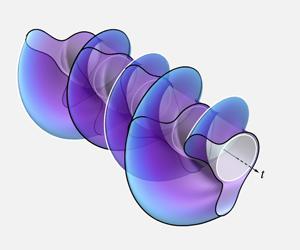当前位置:
X-MOL 学术
›
J. Fluid Mech.
›
论文详情
Our official English website, www.x-mol.net, welcomes your
feedback! (Note: you will need to create a separate account there.)
Reduced-order modelling of thick inertial flows around rotating cylinders
Journal of Fluid Mechanics ( IF 3.6 ) Pub Date : 2020-06-24 , DOI: 10.1017/jfm.2020.421 Alexander W. Wray , Radu Cimpeanu
Journal of Fluid Mechanics ( IF 3.6 ) Pub Date : 2020-06-24 , DOI: 10.1017/jfm.2020.421 Alexander W. Wray , Radu Cimpeanu

|
A new model for the behaviour of a thick, two-dimensional layer of fluid on the surface of a rotating cylinder is presented, incorporating the effects of inertia, rotation, viscosity, gravity and capillarity. Comparisons against direct numerical simulations (DNS) show good accuracy for fluid layers of thickness of the same order as the cylinder radius, even for Reynolds numbers up to $Re\sim 10$ . A rich and complex parameter space is revealed, and is elucidated via a variety of analytical and numerical techniques. At moderate rotation rates and fluid masses, the system exhibits either periodic behaviour or converges to a steady state, with the latter generally being favoured by greater masses and lower rotation rates. These behaviours, and the bifurcation structure of the transitions between them, are examined using a combination of both the low-order model and DNS. Specific attention is dedicated to newly accessible regions of parameter space, including the multiple steady state solutions observed for the same parameter values by Lopes et al. ( J. Fluid Mech. , vol. 835, 2018, pp. 540–574), where the corresponding triple limit point bifurcation structure is recovered by the new low-order model. We also inspect states in which the interface becomes multivalued – and thus outside the reach of the reduced-order model – via DNS. This leads to highly nonlinear multivalued periodic structures appearing at moderate thicknesses and relatively large rotation rates. Even much thicker films may eventually reach steady states (following complex early evolution), provided these are maintained by a combination of forces sufficiently large to counteract gravity.
中文翻译:

旋转圆柱体周围厚惯性流的降阶建模
提出了一种新的旋转圆柱体表面二维厚流体层的行为模型,该模型结合了惯性、旋转、粘度、重力和毛细作用的影响。与直接数值模拟 (DNS) 的比较表明,对于厚度与圆柱半径相同数量级的流体层,即使雷诺数高达 $Re\sim 10$ 也具有良好的准确性。揭示了丰富而复杂的参数空间,并通过各种分析和数值技术加以阐明。在中等旋转速率和流体质量下,系统表现出周期性行为或收敛到稳定状态,后者通常受较大质量和较低旋转速率的青睐。这些行为,以及它们之间转换的分叉结构,使用低阶模型和 DNS 的组合进行检查。特别关注参数空间的新可访问区域,包括 Lopes 等人针对相同参数值观察到的多个稳态解。( J. Fluid Mech. , vol. 835, 2018, pp. 540–574),其中相应的三重极限点分岔结构由新的低阶模型恢复。我们还通过 DNS 检查接口变为多值的状态 - 因此超出了降阶模型的范围。这导致高度非线性的多值周期结构以中等厚度和相对较大的旋转速率出现。即使是更厚的薄膜也可能最终达到稳定状态(经过复杂的早期演化),
更新日期:2020-06-24
中文翻译:

旋转圆柱体周围厚惯性流的降阶建模
提出了一种新的旋转圆柱体表面二维厚流体层的行为模型,该模型结合了惯性、旋转、粘度、重力和毛细作用的影响。与直接数值模拟 (DNS) 的比较表明,对于厚度与圆柱半径相同数量级的流体层,即使雷诺数高达 $Re\sim 10$ 也具有良好的准确性。揭示了丰富而复杂的参数空间,并通过各种分析和数值技术加以阐明。在中等旋转速率和流体质量下,系统表现出周期性行为或收敛到稳定状态,后者通常受较大质量和较低旋转速率的青睐。这些行为,以及它们之间转换的分叉结构,使用低阶模型和 DNS 的组合进行检查。特别关注参数空间的新可访问区域,包括 Lopes 等人针对相同参数值观察到的多个稳态解。( J. Fluid Mech. , vol. 835, 2018, pp. 540–574),其中相应的三重极限点分岔结构由新的低阶模型恢复。我们还通过 DNS 检查接口变为多值的状态 - 因此超出了降阶模型的范围。这导致高度非线性的多值周期结构以中等厚度和相对较大的旋转速率出现。即使是更厚的薄膜也可能最终达到稳定状态(经过复杂的早期演化),











































 京公网安备 11010802027423号
京公网安备 11010802027423号